|
EQUINE CLICKER TRAINING..... using precision and positive reinforcement to teach horses and people |
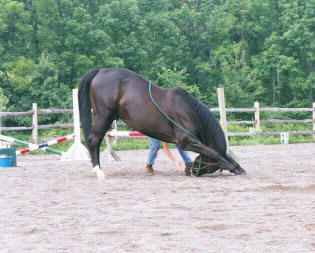
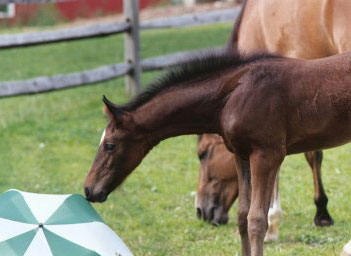
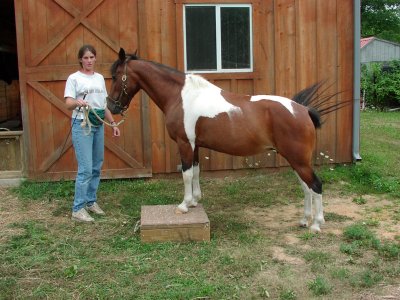
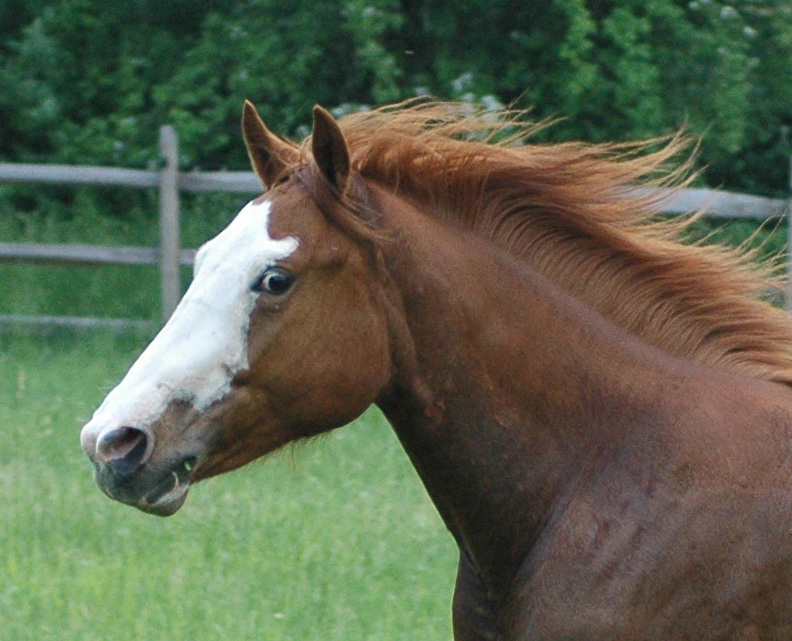
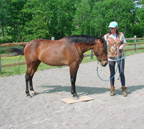
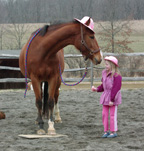
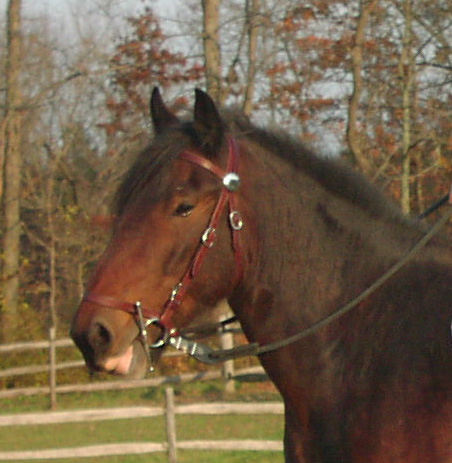
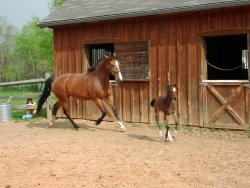 |
|
Should you click offered behavior? A Look at Stimulus Control
One of the questions that seems to come up on a regular basis with novice clicker trainers is whether or not to click offered behavior. Offered behavior is behavior that the horse offers without being cued. The simple answer is that if I want the behavior to be under stimulus control, then I do not want to click when the horse offers an uncued behavior. But on the other hand, there are times when I am actively shaping behavior, or the behavior is new enough that I don't have a formal cue, and it is ok if the horse offers behavior off cue. Depending upon where I am in the shaping process, I have to decide whether or not to click. In addition to these considerations, I have to take into account that I don't want to squelch the horse's enthusiasm and I may want some behaviors as default.html behaviors which are behaviors that I have on a high reinforcement rate whether they were cued or not (more on them later). All these things need to be taken into consideration and it makes the whole question of "Do I click it?" very murky.
I found that I needed to balance out all these factors to come up with a consistent strategy for dealing with uncued behaviors. But before I even decided what to do about offered behaviors, I had to recognize that even though I did not think I had cued a behavior, it doesn't mean that the horse didn't interpret something as a cue. In this sense, there are very few "uncued" behaviors and in a lot of cases, it is a matter of looking at what is going on and deciding upon an appropriate strategy. When people ask me if they should click offered behaviors, I end up saying "it depends" which is probably accurate, but not very helpful. The point of this article is to provide some framework for how to think about offered behaviors and then provide some examples of how I decide whether or not to click.
When I first started thinking about how to offer guidelines for whether or not to click, I thought the best idea would be to provide examples of times when I do and do not click and allow people to find the situation that most closely matched their own situation. I think it does help to have some concrete examples. so I am going to include this list later in the article with some descriptions but I want to make start by explaining a bit about how offered behaviors fit into the shaping and learning process. Actually after I had started writing and really doing some thinking about guidelines for when to click, I thought I could just summarize this whole article by saying that whether or not you click depends upon whether or not you are including stimulus control in the list of criteria for that behavior at that time. But I am not sure this would make sense unless you go through the thought process that I followed, so I decided to write down how I came to this conclusion.
STIMULUS CONTROL AND SHAPING
I started thinking about where offered behaviors come from and how they fit into the shaping process. I realized that when people talk or write about how to handle offered behaviors, the subject of stimulus control always comes up. The idea is that in the shaping process, I would allow some offered behaviors because that is part of the shaping process, but that once I have a behavior under stimulus control, it needs to stay under stimulus control. The idea is that clicking uncued behaviors after I have a behavior on cue will make it difficult to keep a behavior under stimulus control. While I think this can be true, I think training is more flexible than that. But before we get any farther, I want to define stimulus control as explained by Karen Pryor. A behavior is under stimulus control when it meets 4 criteria:
1. The animal performs the behavior when the cue is presented 2. The animal does not perform the behavior if the cue is not presented (within that training session - what they do on their own time is not relevant) 3. The animal does not perform another behavior when presented with the cue 4. The animal does not perform that behavior when presented with another cue
I think that when we first shape behavior, we would agree that we only have minimal stimulus control. Clicker trainers like to talk about not having a cue when a behavior is being shaped and I want to point out that this means that the behavior does not have a formal cue attached to it, but as soon as I start shaping something new, the horse is going to starting making associations between what I do, what I hold, how I stand, where I am, and so on. So from the very beginning, there are cues that the horse is using to help it figure out what behavior might be reinforced. My point is that that if I am shaping, I have already started some kind of stimulus control.
I would also like to point out that offered behaviors are an expected and important part of the shaping process. In the shaping process, I am going to train a behavior by clicking all the small steps that lead to the larger behavior. One of the rules of shaping is that I should only concentrate on one criteria at a time and when I raise one criteria, I relax the others. Shaping well is about knowing when to raise the criteria and when to be flexible so that progress can be made without asking too much of the horse. There are a few other things to remember about criteria. One is that while I am the one to decide what the criteria will be to earn a click, I decide this based upon what the horse is offering. I can decide to raise my criteria if the horse offers something beyond that which I had been clicking. And I can decide to lower my criteria if he is not meeting them on a regular basis.
Let's look at the example of mat work. If I want my horse to learn to stand on a mat, I am going to click every time he moves toward the mat. If I start with a horse that is afraid of the mat, I am going to slowly change the criteria so the horse steps closer and closer to the mat. At this point, I will click if the horse places his foot in a predetermined range around the mat. As he gets closer and closer to the mat, I might change the criteria so that he actually has to step on the mat. At this point, my criteria might be one foot on the mat. If the horse offers two feet on the mat, I am probably going to click it even though that behavior was not what I was after at that point, which was one foot on the mat. At the same time, if my horse offers to stand outside the zone I have chosen, I am not going to click it. When shaping, I only focus on the behaviors I want, but I have to remember that horses are doing lots of different behaviors in any shaping session. The reason for the clicker is to mark those behaviors I like and this is the focus of my training. But I also need to remember that the horse is also learning that there are other behaviors that will not be reinforced. I just point this out to show that from the very beginning, horses are exposed to the idea that if they offer something different than what I want, I will not click it, even if it is something that has been reinforced in the past.
Continuing with this example of mat work, I want to show how I change my criteria to shape behavior. In shaping I want to concentrate on one aspect of the behavior at a time. In mat work, some possible criteria are standing near the mat, one foot on the mat, two feet on the mat, standing square on the mat, duration, ears forward, posing and so on. When I initially train mat work, I will allow the presence of the mat to be the cue for the horse to stand on it. At some later point, I then teach the horse to wait until I ask him to stand on the mat. I add the part of stimulus control that says the horse waits for the cue before offering the behavior. But what if I now want to go back and improve my horse's mat work. If I start doing active shaping again, and my horse gets put on a high rate of reinforcement for mat work, he is probably going to get eager to stand on the mat and I might lose what stimulus control I had put in place. Initially I perceived this as a problem because I would now have to go back and teach stimulus control for mat work all over again. But what I found was that this doesn't end up being a big issue because I have already established a basic understanding of the mat cue and stimulus control for it. It is just a matter of tightening that criteria back up after I am done shaping the new detail.
Remember that during the shaping process, if I am looking for improvement in one aspect of the behavior, I might have to relax a few other criteria in order to help the horse be successful. If instead of viewing stimulus control as this final and unchangeable thing, I now view stimulus control as just another criteria as part of the shaping process, then that means that it can come and go. There may be times when I have a behavior under stimulus control, but then I want to improve the behavior and in order to do so, I might have to relax the criteria of stimulus control so I can make improvement in another quality of the final behavior.
A mat training session might go like this:
mat session 1: criteria - feet near mat mat session 2: criteria - one foot on mat mat session 3: criteria - two feet on mat, or one foot on mat and standing quietly mat session 4: criteria - two feet on mat mat session 5: criteria - two feet on mat and standing quietly for 2 counts mat session 6: criteria - waiting until cue and two feet on mat (I have added in a cue here - beginning of stimulus control, I have relaxed the duration requirement) mat session 7: criteria - waiting until cued and two feet on mat for 2 counts mat session 8: criteria - waiting until cued and two feet on mat for 10 counts mat session 9: criteria - waiting until cued and two feet on mat and ears forward (I have added ears forward, relaxed 10 counts - only change one criteria at a time) mat session 10: criteria - two feet on mat and ears forward - note: I am no longer waiting for it to be cued because this horse only puts his ears forward as he approaches the mat. If I make him stand and wait, he gets worried. Relax the "stand and wait for cue" criteria to get ears forward. mat session 11: criteria - waiting until cued and two feet on mat and ears forward (now I can put the criteria of waiting for the cue back in)
Can you see how having the behavior on cue is just another criteria and you can add it or relax it as you go through the shaping process? The question is when is it appropriate to do this and when do you need to really stick to your stimulus control? This is where you have to do some thinking because every situation is different. The nice thing about horse training is that if you have relaxed stimulus control when it was counterproductive, your horse will tell you by a deterioration in his behavior, frustration or confusion over what the cue.
There are two key points here. The first is that anytime you click an offered behavior, you have to assume that you are going to get more of it. So deciding whether or not to click is not just about if you like that behavior and appreciate your horse offering it to you, it is also about DO YOU WANT or CAN YOU DEAL WITH more of that behavior now. The second key point is to know your horse and what matters to you. Stimulus control is a very personal thing. Different people will choose to have different behaviors under tight stimulus control. It depends upon your situation and also upon your horse. A very laid back quiet horse can be allowed more latitude in offering behaviors than a young, energetic horse.
HOW DO YOU DECIDE WHETHER OR NOT TO CLICK? Here are some general guidelines:
1. SAFETY FIRST:
If the behavior would be dangerous if offered off cue, then work on stimulus control early in the shaping process. Examples of behaviors I never click except when cued would be leg movements, especially front legs forward and any behavior that involved the horse moving into my space. I am also quite careful about whether or not to click any behavior that adds speed or energy. Whether or not I click those depends upon the horse, current situation and how confident I feel about my riding ability. If I don't want a horse to offer a behavior off cue, I associate it with many different kinds of cues so that all of them have to be present for the horse to offer the behavior. Willy's Spanish Walk has 4 cues (a verbal, postural (on my part), environmental, and whip). By making a cue with many components, he is very unlikely to offer it unexpectedly.
2. LOCATION:
If there are behaviors that you never want in some situations, then never click them in those locations from the very beginning. Horses are very sensitive to environmental cues. If you don't want your horse offering head lowering over grass, then NEVER click it there. If at some point, you decide to change that rule, you will be able to do so but be consistent from the beginning if you think this is important to you.
On the other hand, if I have taught a behavior in one location but it is one that I eventually want my horse to offer in other locations, I will click if the horse offers it in a new place. So, for example if I have taught head lowering in the stall and put it on cue so that I no longer click it off cue in the stall, but the horse suddenly offers it while walking in the ring, I will click it, unless I am specifically working on something else.
Grouped in this category would be what I consider "isolated events." If I am taking a horse to the field and as I take the halter off, he poses. I might click it because I am leaving and I don't mind if he wants to practice his pose. I don't have to worry about clicking for the pose interfering with what I do next because he is off on his own time and I am leaving. If he offers the pose while walking to the field, that is different. Do I want him to think he should pose all the way to the field? Would I want that? If he poses again and I do not click, will he be frustrated?
3. LEVEL OF THE HORSE:
By level of the horse I mean how clickerwise the horse is and how much the horse understands about stimulus control. In the early stages of clicker training, horses offer a lot of behaviors and don't really understand about cues yet. At some point, I introduce cues and start asking the horse to wait until I give the cue. Usually once the horse has learned about cues for a few behaviors, it becomes easy to add cues to new behaviors. In the same way, once a horse has learned to do a behavior on cue, it will become better about waiting for the cue, and also about being redirected if it offers a behavior too early or when I have not cued it.
When I first started out, I did not click my horses for behaviors that were offered off cue, but it did not stop them from offering them in certain situations and I realized that one of the things that happens is that as the horses become more sensitive, they start to cue off pre-cues. This means that because they are anticipating, they pick up on habitual things I do before I give what I consider to be the cue. Given the chance, the horse will start to use these pre-cues as cues and soon the pre-cue is the cue. This is not always a bad thing as it can lead to horse responding to more and more subtle cues. Because I did not want to discourage this, I started experimenting with allowing them to show me what they perceived as the cue.
An example of this would be working on walk-trot transitions under saddle. I am using a riding example here because I had a hard time figuring out how to deal with offered behaviors under saddle. Initially I wanted very tight stimulus control on most of the behaviors I was training under saddle but at some point I started to realize that my horses were losing some of their enthusiasm and also that I was already allowing certain types of offered behaviors. I decided that I might as well come up with a strategy for taking advantage of the enthusiasm that comes with offered behavior as long as I could do it while still keeping things safe. When I start walk-trot transitions with young horses, I have the trot on a high reinforcement rate in the initial training sessions . I want the horse to figure out that trotting is good and be enthusiastic about stepping off. At some point, they all get over-eager and start offering trot before I am ready. I don't want to discourage the energy and enthusiasm, and they may not have yet learned the ridden cue to go from trot to walk, so I often click these offered trots.
But I have to recognize that if I click the trot, I am going to get more of it. So, if I am not ready yet to work on the trot, I click and then immediately put the horse on a high rate of reinforcement for doing something else. What this means is that as soon as the horse is offering trot without being cued, I start putting it on stimulus control. If I have a very enthusiastic horse, I might do a few rides with no trotting at all, just to remind the horse that there are lots of other clickable behaviors. Then I will go back to the trot later. In general, I do not click offered trots after the first initial sessions until I know that if the horse starts to trot, I can easily bring him back to a walk. Once the horse allows this redirection, then I know that I have the option of being a bit more adjustable about stimulus control for the trot. Even then, I probably keep the trot transitions on cue until I get to a point where I am working on improving the quality and can put stimulus control aside for a brief time.
There does come a point when I want to work on improving the walk-trot transitions and I am doing a lot of trot transitions. In this session, I will relax my stimulus control and I might click any walk-trot transition whether I cued it or not, if the transition is good. Does this cause some initial confusion? Yes, a little, but what my horses have learned is that when I am actively working on one behavior (trot transitions), the rules of stimulus control are relaxed. How do they know what I am working on? They can tell by what I am clicking and I also usually work in sets. So if I am working on improving trot transitions, I will set up a very simple pattern and start clicking for trot transitions looking for those that are better.
Because my horse knows we are working on trot transitions, he is anxious to offer them. I know that at some stages, a transition that is freely offered by my horse is often better than one where I ask, so I will relax my stimulus control and go ahead and click any higher quality transition. I can do this because I spent the time working on stimulus control in the early trot work and I know that I can get it back. And I want to emphasize that if at some point I feel as though the horse is no longer paying attention to me, but just trotting off on his own agenda, then I tighten my stimulus control again. Permission to trot off without being asked can be revoked at any time. This is really important. My horse is allowed to offer the trot and I have multiple options: I can disallow it, I can allow it and not click it (if it is not good enough) or I can allow it and click it.
One interesting side effect of this is my horses get very good at listening to my body and aids through the trot transition. They are very aware of if I am going with them and allowing the trot, or if I want them to walk. It is a nice way to start teaching horses about how to listen to what my whole body is saying and not just guess what I want based on one isolated aid or cue.
Over time the horses seem to have learned when they can offer upward transitions and when I don't want them. Sometimes they learn by trying it. They will offer the trot and if I disallow the trot and don't click it, they seem to know that trotting is not permitted yet. They asked the question "are we trotting yet?" and I said "no" so they look for other behaviors to offer. What this means is that I can change how much stimulus control I have over the trot on a regular basis and the horses figure it out. If I come out one day and I don't want any offered trots or canters, I just consistently bring the horse back and they stop offering.
Another thing I have noticed is that my horses keep what I think of as a "mental list" of behaviors that have been clicked in any given session. If I have asked for and clicked a behavior, then it goes on their mental list of clickable behaviors. What this means is that when I come out and walk around doing my warm-up, the horses either offer behaviors on cue or offer behaviors that are associated with the walk (probably because I am more relaxed about stimulus control at the walk). However, I find that once I have clicked trot or canter, the horses put it on their mental list of behaviors I might like and are more likely to offer it again in response to the cue or what they think might be the cue. Therefore in any given ride, if I have already done some trot work, they might offer a trot. Same with the canter. If it has been clicked already during that ride, then to them it is a behavior I might possibly want.
There is another little piece here that is nice. Willy is 22 this year and has had some soundness issues. Some days he comes out and wants to trot right off and other days he does not. What I have learned to do is to warm him up at the walk and let him choose when he is ready to trot. At some point when I am working on lateral work or marching forward, I will start asking for more energy and when he is ready he will trot. I put the suggestion of the trot out there and he gets to decide when he is ready. I could come out and cue him to trot and he would, but I find that by letting him choose the timing, I get a better trot and he is happier in his work because I am not asking before he is physically ready.
This probably all sounds very sloppy but I find it works well for me. I am sharing it here, not so you can do exactly the same, but so you can see how I can balance out the need for stimulus control with other factors. I hope these examples show how I can adjust my level of stimulus control on any given behavior in order to improve my training. In addition to presenting the idea of looking at stimulus control as just another criteria in the shaping process, I do want to go into a bit of detail about some common situations where horses offer behavior and how I usually decide whether or not to click.
There are various "types" of offered behaviors and I find that I treat offered behaviors differently depending upon which category they fall into. This is an oversimplification and there is a bit of overlap between the various scenarios I am going to describe. But that's ok. The point of this article is not to give you set rules for deciding how to handle offered behaviors, but to help you think about how to handle them in your own situation and understand a bit more about the training process. My hope is that you might find some examples that relate directly to your own training, and also that this article makes you rethink what is going on when your horse asks the question "is this what you want?"
There are four basic categories of offered behavior:
1. ANTICIPATION: This occurs when the horse offers the behavior before I am ready or have cued it because he is eager and anticipating the cue. I would treat this as a normal part of refining cues and developing stimulus control. In all honesty, if this doesn't happen a little bit when I am training a new behavior, I get a little worried that the horse is not getting it, or is not enthusiastic about the training process. I actually like to have the horse be over-eager a few times. But I have to ask myself a few questions before I click when a horse is offering a behavior out of anticipation.
Is it safe? Do I need to have this behavior on tight stimulus control? If yes, then I need to make sure that the horse waits until I ask. It is important to remember that the enthusiasm is good and I don't want to discourage that, so it is better to just redirect the horse and ask for another behavior and click that. If this happens a number of times, I need to make sure that I am not creating a behavior chain with the horse offering the original behavior so I will ask him for something else. I also need to ask myself if the horse is consistently offering the behavior in response to something I am doing and there is confusion over the cue. The cue that I have chosen is not always what the horse perceives as the cue. If I decide that the horse is consistently cueing off something I am doing before I give my original cue, then I need to decide if allowing that to become the new cue is going to be a positive change or if I want to ask the horse to wait until I give the original cue.
An example of this would be teaching a horse to step on a mat. In the beginning, the mat has no meaning for the horse and I am going to ask him to move forward and back, clicking for moments when he puts his foot or feet near/on the mat. At this point I could say that I have no cue for the horse to stand on the mat, or I could say that leading the horse toward the mat is the cue for the horse to stand on it. What I have found is that horses love mat work and at some point, the mat becomes the cue. My horse sees the mat and wants to go right over and stand on it. I could say that the horse is offering the behavior without being cued, but in the horse's mind, he is being cued by the presence of the mat. Therefore I will allow the horse to go to the mat as long as he is being polite (not dragging me).
But now that I know the horse likes the mat, I will start reinforcing him for standing still near the mat and waiting for me to ask him to step on the mat. This is the first step toward building stimulus control and my chance to insert the cue I want for going to and standing on the mat. This is not unlike the riding example where as soon as the horse gets pushy about picking up the trot, it is time to add some stimulus control.
2. CONFUSION: I am referring to offering a behavior out of confusion: In some ways, this is an easy one. If I am training a new behavior and I ask for a change and the horse offers a different behavior, I am not going to click it. But there is a qualifier here. It is always important to look at why the horse offered that particular behavior. Sometimes it can show you that your cues are not clear or that the horse is not set up to offer the desired behavior. I also find that if my horses get confused or upset, they will sometimes offer a well known, highly reinforced default.html behavior. In my anthropomorphic way, I tend to interpret this as the horse showing me he is trying and wants to offer something. I might actually click if the horse has been getting a little agitated and has now reconnected with me to offer something I might like.
An example of this is when I am working Willy in-hand, I often mix in head lowering with the other work. Usually I ask for it, but sometimes he offers it and I decide whether or not to click those offerings on a case by case basis. Sometimes it is clear that is getting worried and he puts his head down and takes a little break. He is very polite about it so I allow it and I might also click it. I would not do this with a horse that was still learning about the different kinds of rein cues and put his head down when I was trying to teach him to rock back or give to the bit. I always have to balance out whether or not the click is going to help the horse learn the desired behavior. The click is supposed to add clarity so don't muddy up your shaping sessions by clicking behaviors you like but don't want at that time. And remember that you do have the option of allowing a behavior but not clicking it. If your horse needs a little mental break and drops his head or wants to stand on a mat, I might allow it but just not click.
3. GUESSING: If the horse is just throwing behaviors at me, the horse is guessing or trying to get my attention. When I go out to the barn at night, I give the horses their late night hay and check their water, stalls etc.. If I have time, I will play some clicker games with them. If Willy is bored or wants to come out, he will start throwing behaviors at me over his stall door. He has quite a large repertoire and he will yawn, smile, shake his head, wiggle his lips, pose and do whatever else he can think of. I have not specifically cued any of them, but he uses my presence as a cue that he might get reinforced for something.
I try not to encourage this frenzy to get my attention, but I am aware that he wants to do something. At this point, it is not about the food with him. It is about coming out to play. If he does a particularly wonderful example of a behavior, I will click it, but more likely, I will stop and then ask him to do it again and click that effort. I think it is important to recognize that sometimes horses want our attention. Some of my horses have come up with terrible ways to get my attention such as banging doors, scraping their teeth on walls and making other general noise. If I have a horse that is willing to offer behaviors to get me to come and play, then I want to pay attention to that. Part of the joy of clicker training is that we learn to communicate with our horses and they learn to communicate with us. I don't want this to become a one way street of you only do it if I cue you. I want to allow the system to be flexible enough that my horses have "safe" behaviors that they can use to communicate with me.
I would put default.html behaviors in this category, not because the horse is necessarily guessing but because I think my horses use default.html behaviors both to earn clicks and to get my attention. I think they also use default.html behaviors to show me that they are now paying attention, especially if they have gotten distracted and are now trying to reconnect with me. I wrote about default.html behaviors extensively in my article on training duration which is in the training section on this website (http://www.equineclickertraining.com). The short explanation is that they are behaviors that I click and treat on a high rate of reinforcement, but that I do not necessarily actively cue. I have discovered that while I thought many of my default.html behaviors were "uncued," most of them do have cues, but they are environmental (location etc...) or based on my presence or body posture so the cues are very subtle. Rosie has ears forward as a default.html behavior but she definitely cues off things like eye contact, my position relative to her and my body posture.
4. RANDOM: I am not sure random is quite the right word but it often seems random and as if the horse is offering a behavior "out of the blue" because I haven't clicked anything in a while. I could have included this in with horses offering behaviors when they are guessing, but to me it is a slightly different category. When I am with my horse I am always training him and I am very aware of this when working with new horses which I like to keep on a high rate of reinforcement. But at some point as we get more comfortable together, there will be times when I am not clicking as much and the horse is unsure if I like what he is doing and should keep doing it, or if he should offer something new. So the horse will offer a behavior "out of the blue." I am using the phrase "out of the blue" because that is often what it feels like to the rider or handler. But I usually find that there was some kind of context cue that made the horse think of offering that particular behavior at that particular time.
I have a young horse (Red) who is now learning about duration at the trot. I had done some trot work last fall and built up to some duration, but in the winter when it was cold and blustery, I had been doing a lot of bendy work with trots in short sets, clicking for bending and softening. Last fall I had also introduced the canter and we practiced it a few times before I let it rest for the winter. The other day I was riding him and went back to working on longer trots. At one point we had gone almost the whole way around the ring and he suddenly offered canter. I was quite surprised but it was a beautiful smooth departure so I clicked it. I clicked it because the quality of the transition was better than what I had been getting before when I had been working on it and because I didn't mind if he offered it.
This is where things get personal. In deciding whether or not to click it, I had to make a snap judgment about the quality of the canter and if I felt comfortable with this horse cantering off cue. I was ok with it, so I clicked it. I think part of the reason he offered canter is that he had been trotting for a while and not been clicked, and he was in the general area where I had worked on canter before. Did I really want him offering canter off cue? No. So, the next time I came around, I clicked for trotting before he got as far around and when I was in that general area, I asked for a very specific alternate behavior (a turn) which I then clicked. The message I wanted to give was "cantering was ok and it was a beautiful canter, but we are not working on that now." If I had felt uncomfortable with this horse cantering off cue, I would not have clicked that offered canter. I would have just asked him to go back to trot or even walk and clicked for that.
WHAT IF YOUR HORSE GETS UPSET WHEN YOU DO NOT CLICK OFFERED BEHAVIORS
Enthusiasm is a good thing and one reason I have spent so much time writing and thinking about how to handle offered behaviors is that I want my horses to be enthusiastic about their work. But enthusiasm implies emotion and there are times when emotions get in the way of training. Every time that a horse offers a behavior and does not get clicked, there is the potential for frustration. This is one reason that stimulus control is so important. I hope I have explained that I do not allow a horse to offer a behavior at stages beyond the very initial shaping unless I know that the horse can either be redirected or will be ok with not being clicked. This is something that comes with time (I wrote about the level of the horse), personality and it also depends in part upon the skill and experience of the trainer.
This really is a whole topic for an article itself, but if I am training a horse that gets frustrated when he offers a behavior and does not get clicked, there are some simple questions I can ask myself about what is happening.
1. Does the horse understand the cue? Maybe the cue is not as clear as I think. I ask myself if I am being consistent in how I present the cue. I might go back and test it out in various situations. Maybe I just need to go back and review the cue. I also need to review the 4 parts of stimulus control (listed in the beginning of this article). There is more to stimulus control than just having the horse do the behavior when asked.
2. Do I need to be quicker about redirecting the horse to a behavior that I do like? This is one way to teach stimulus control and it is explained very well in Alexandra Kurland's video on stimulus control. Again, it comes back to stimulus control, but until you get full stimulus control, it is important for the horse to allow you to redirect him without getting emotional.
3. Is the horse offering the behavior because I am not being pro-active about asking for something else? This is related to redirection, but also to thinking ahead. In my riding example, Red cantered when I was not expecting it. If I had chosen not to click and he had gotten annoyed because I did not click, I would not click him the next time he offered canter. Instead I would click him for coming back to the trot and the next time I felt him even thinking about canter, I would have asked for something that he could not do while cantering.
4. Do I need to work on my horse's emotional control in general? If I have a horse that is very overeager and anxious and gets frustrated about getting the wrong answer, I am going to mix up sessions where he works on calming behaviors with other behaviors. I might also consistently redirect him to calming behaviors if he starts throwing behaviors at me and getting frustrated.
5. Is my reinforcement rate too low? Horses tend to offer behaviors when they are trying to figure out what I want and I am not clicking enough. This is tied in with understanding the cue, stimulus control, and the horse's emotional state, but it can also happen if I am too quick to try and build duration or if the horse is not being kept busy enough doing things that are being clicked or could be clicked.
6. Am I working on too many behaviors at once? I have one horse who gets really annoyed when she doesn't know exactly what I want. If I am working on too many similar behaviors at once, she will get anxious. For her, I have to be very clear about what we are working on and I do not reward a lot of offered behaviors unless I have a new behavior that I am trying to generalize to different locations or situations.
With a horse that is easily frustrated it may be that at this stage in his training, I have to be very consistent about stimulus control. That may imply emphasis on not clicking for offered behaviors, but what I really want to do is set up my training so the answer is crystal clear and he gets lots of right answers. I find that if the horse gets lots of right answers, a wrong answer which is not clicked has a very limited emotional impact. This means that I need to come up with a very clear training plan ahead of time so that I can be "with" the horse at every moment. If I leave an opening for the horse to "guess," he will take it and I don't want to set him to have to guess and then deal with a wrong answer.
I also want to mention that even experienced horses and trainers can fall into the pattern of expecting or giving a click for every correct behavior. When I am shaping it is easy to have some behaviors that don't get clicked and my horse just learns to try again. Once the behavior is good enough to start putting into use, I will keep the reinforcement rate high as I might be asking for it in new situations. But I have to remember that at some point, I will need to go back to reinforcing only some correct responses with a click and treat. Otherwise the horse gets in the habit of expecting a click and this can lead to frustration. If I am not sure where I am in this process, I will work the behavior in sets, mixed in with other behaviors and only reinforce some responses. The horses learn that if I am working on a number of behaviors, any of them could be reinforced at any time so they need to just keep trying.
So, should you click offered behaviors? Definitely. Just remember the general guidelines:
1. Is this a safe and appropriate behavior to allow off cue? 2. Do I want more of it right now? If so, then click 3. If I get more of it, can I deal with it? Is a little ok, but a lot too much? If so, click then redirect 4. Is the tradeoff of getting better quality or allowing the horse to "practice" worth the loss in stimulus control? 5. Do I have enough stimulus control already in place that I can get it back? 6. Will this benefit my horse's training in general? (will it make a shutdown horse more interested, will it make a distracted horse more focused or less focused?)
I have to say that I do I love moments when my horses offer something unexpected. While horse people talk about well trained horses and wanting their horses to be under "control,' I have noticed an interesting thing. If you get a group of horse people together and they are swapping horse stories, the ones they tell are often about those times when the horse took some initiative and figured something out himself. I think that we do truly love it when our horses are bright, enthusiastic and creative and if we are going to use clicker training to improve our communication with our horses, we better leave some doors open for the horse to communicate back to us.
Katie Bartlett, April 2007 - Please do not copy or distribute without my permission.
Home | Articles | Clicker Basics | Community | FAQ | Getting Started | Horse Stories Links | Photos | Resources
|
||||